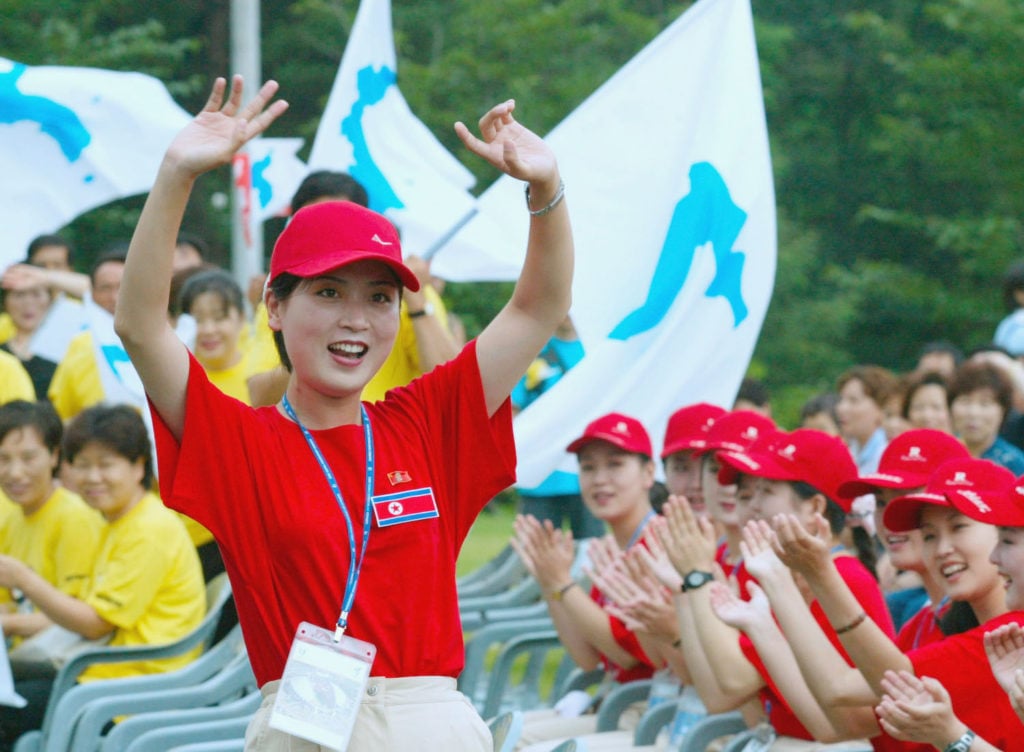Art World
North Korea Is Sending a Massive ‘Art Troupe’ to Perform at South Korea’s Winter Olympics
Kim Jong-un's plans for the Winter Olympics are heating up.

Kim Jong-un's plans for the Winter Olympics are heating up.

Sarah Cascone

With next month’s Pyeongchang Olympics rapidly approaching, there are more and more signs of a possible rapprochement between North and South Korea. The two countries, divided at the 38th Parallel since receiving independence from Japan at the end of World War II, will march as one at the Winter Games, and North Korea has announced plans to send a 140-member “art troupe”—as it is termed in the nations’ joint announcement—to perform twice during the main event.
The art troupe will consist of the hermetic Northern country’s Samjiyon band—an 80-person orchestra—and 60 other singers and dancers, according to the announcement. “North Korea said that programs will likely consist of folk songs and masterpieces that fit the theme of unification and are well known to both South and North Koreans,” said Lee Woo-sung, South Korea’s chief delegate, reported the Yonhap News Agency.

Officials from the Koreas met Monday to work out details about North Korea’s plan to send an art troupe to South Korea during next month’s Winter Olympics. Hyon Song Wol, the head of the Moranbong Band, second right, also attended the meeting. Photo courtesy of the South Korea Unification Ministry.
According to the Strait Times, a seven-person advance team—led by Hyon Song Wol, head of the Moranbong Band, a popular North Korean girl group—will make the trip to South Korea this weekend to visit the performance venues. Founded by order of Kim Jong Un in 2012, the group is known for its Western-style costumes and music (one of their numbers is a cover of the Rocky theme), but its participation in the Olympic performances has yet to be officially confirmed.
The North Korean website mentions performances by the Mansudae Art Troupe as being staged at the East Pyongyang Grand Theatre but offers no details about the group. Better known is the country’s Mansudae Art Studio, a propaganda outfit which has been enlisted by various African countries to produce large-scale monuments.

South Koreans wave unification flags during a rally to mark the 63rd Independence Day in front of Japanese embassy on August 15, 2008, in Seoul, South Korea. Photo courtesy of Chung Sung-Jun/Getty Images.
As the frigid relations between the two Koreas appear to be thawing, there is concern that North Korea is preparing to stage a military parade on February 8, the day before the games’ opening ceremonies timed to the 70th anniversary of the founding of the North’s regular army. The Strait Times cited reports of 12,000 soldiers seen rehearsing this week but noted that there had not been the usual level of activity typically expected ahead of a major military display.
The North Korean Olympic delegation also plans to include athletes, officials, journalists, a cheering group, and a taekwondo demonstration team. Though North Korea failed to respond in time to claim the spot for its only qualifying athletes, a pairs figure-skating team, there is still the possibility of wild card slots. The two Koreas are also in talks to field a joint, expanded women’s ice hockey team, pending Olympic approval.

South Korean volleyball player Ku Min-jing, right, and North Korean former basketball player Kim Seong Ho carry a unification flag symbolizing one Korea during opening ceremonies for the Athens 2004 Summer Olympic Games. Photo courtesy of Stuart Franklin/Getty Images.
These plans, of course, are coming together in extreme last minutes of preparation for the games, as the Pyeongchang Olympics take place February 9–25. The joint Korean flag, showing a blue silhouette of the two countries on a white background, was designed in 1990. The two countries have previously marched together at the Sydney Olympics in 2000, at the Athens Games in 2004, and the Turin Olympic in 2006, but the unification flag has not been officially used by the nations since the 2007 Asian Winter Games.